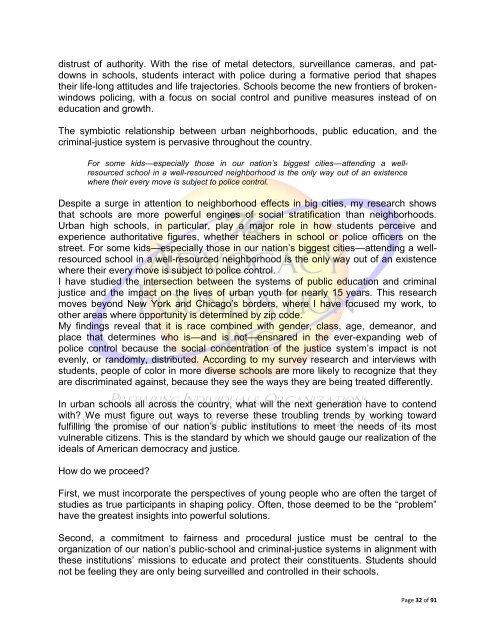Literacy-Based Prison Construction
Literacy-Based Prison Construction
Literacy-Based Prison Construction
Create successful ePaper yourself
Turn your PDF publications into a flip-book with our unique Google optimized e-Paper software.
distrust of authority. With the rise of metal detectors, surveillance cameras, and patdowns<br />
in schools, students interact with police during a formative period that shapes<br />
their life-long attitudes and life trajectories. Schools become the new frontiers of brokenwindows<br />
policing, with a focus on social control and punitive measures instead of on<br />
education and growth.<br />
The symbiotic relationship between urban neighborhoods, public education, and the<br />
criminal-justice system is pervasive throughout the country.<br />
For some kids—especially those in our nation’s biggest cities—attending a wellresourced<br />
school in a well-resourced neighborhood is the only way out of an existence<br />
where their every move is subject to police control.<br />
Despite a surge in attention to neighborhood effects in big cities, my research shows<br />
that schools are more powerful engines of social stratification than neighborhoods.<br />
Urban high schools, in particular, play a major role in how students perceive and<br />
experience authoritative figures, whether teachers in school or police officers on the<br />
street. For some kids—especially those in our nation’s biggest cities—attending a wellresourced<br />
school in a well-resourced neighborhood is the only way out of an existence<br />
where their every move is subject to police control.<br />
I have studied the intersection between the systems of public education and criminal<br />
justice and the impact on the lives of urban youth for nearly 15 years. This research<br />
moves beyond New York and Chicago’s borders, where I have focused my work, to<br />
other areas where opportunity is determined by zip code.<br />
My findings reveal that it is race combined with gender, class, age, demeanor, and<br />
place that determines who is—and is not—ensnared in the ever-expanding web of<br />
police control because the social concentration of the justice system’s impact is not<br />
evenly, or randomly, distributed. According to my survey research and interviews with<br />
students, people of color in more diverse schools are more likely to recognize that they<br />
are discriminated against, because they see the ways they are being treated differently.<br />
In urban schools all across the country, what will the next generation have to contend<br />
with? We must figure out ways to reverse these troubling trends by working toward<br />
fulfilling the promise of our nation’s public institutions to meet the needs of its most<br />
vulnerable citizens. This is the standard by which we should gauge our realization of the<br />
ideals of American democracy and justice.<br />
How do we proceed?<br />
First, we must incorporate the perspectives of young people who are often the target of<br />
studies as true participants in shaping policy. Often, those deemed to be the “problem”<br />
have the greatest insights into powerful solutions.<br />
Second, a commitment to fairness and procedural justice must be central to the<br />
organization of our nation’s public-school and criminal-justice systems in alignment with<br />
these institutions’ missions to educate and protect their constituents. Students should<br />
not be feeling they are only being surveilled and controlled in their schools.<br />
Page 32 of 91

















